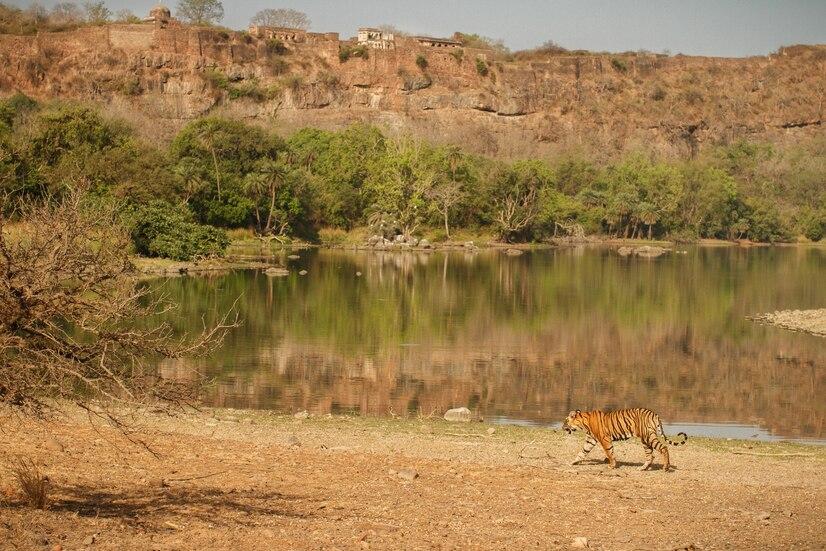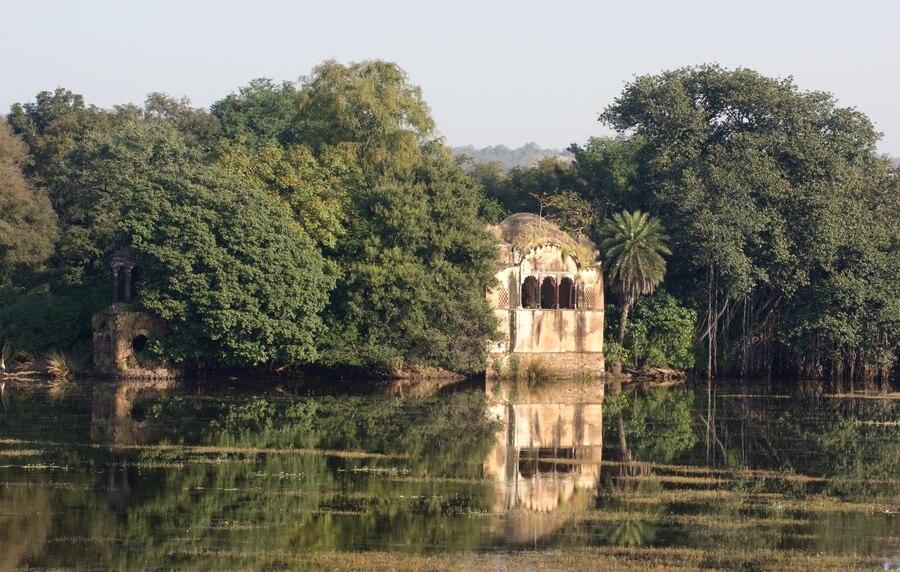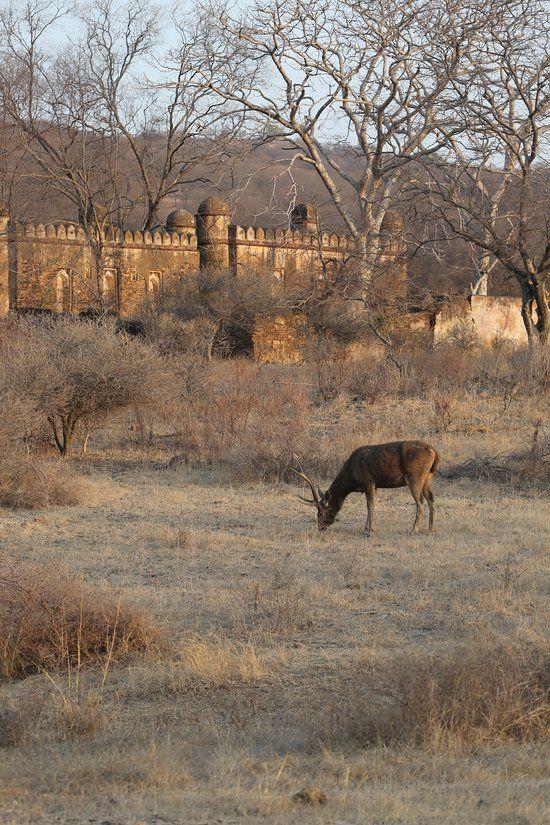



Table of Contents
- Introduction
- Overview of Ranthambore National Park
- Biodiversity and Ecosystem
- Activities for Visitors in Ranthambore National Park
- Overview of Ranthambore Fort
- Historical Background
- Architectural Features
- Cultural Significance
- Visiting Ranthambore Fort
- Conclusion
- Faq's
Introduction
Ranthambore National Park and Ranthambore Fort are two of Rajasthan's most captivating attractions, offering a unique blend of natural beauty and historical significance. Located in Sawai Madhopur district of Rajasthan, this enchanting destination is renowned for its rich biodiversity, including a thriving population of Bengal tigers, as well as its architectural marvels that tell the story of India's royal past.
The fort, a UNESCO World Heritage Site, stands majestically atop a hill, overlooking the sprawling landscapes of the national park. Together, they provide visitors with an immersive experience that combines thrilling wildlife encounters with a deep dive into the region's history. Whether you are an adventure seeker eager to explore the wilderness or a history buff fascinated by ancient architecture, Ranthambore offers an unforgettable journey through time and nature.
 Tiger in Ranthambore National Park
Tiger in Ranthambore National Park
Overview of Ranthambore National Park
Established as a national park in 1980, Ranthambore National Park spans over 1,334 square kilometers and is renowned for its significant population of Bengal tigers. It is part of the Project Tiger initiative aimed at conserving this endangered species. The park's diverse ecosystems include dry deciduous forests, scrublands, and open grasslands, which support a wide range of flora and fauna.
The landscape is dotted with ancient ruins and lakes that enhance its natural beauty, making it not only a sanctuary for wildlife but also a picturesque setting for visitors.
The park is characterised by its rugged terrain, which includes hills and valleys that provide diverse habitats for various species.
The presence of water bodies like Padam Talab and Raj Bagh Talao attracts both wildlife and bird species, making them prime spots for observation. The park's rich biodiversity includes not only tigers but also leopards, sloth bears, various deer species, and several bird species. This remarkable variety makes Ranthambore one of India's premier wildlife destinations, drawing nature lovers and photographers eager to capture its stunning vistas.

Biodiversity and Ecosystem
Ranthambore National Park is home to an impressive array of wildlife:
- Bengal Tigers: The park is famous for its thriving tiger population, attracting wildlife enthusiasts from around the world.
- Leopards: Often spotted in the hilly areas of the park.
- Sloth Bears: Frequently seen foraging for food.
- Deer Species: Including chital (spotted deer) and sambar deer.
- Bird Species: Over 300 species have been recorded, making it a paradise for birdwatchers.
Ranthambore National Park boasts a rich biodiversity featuring various ecosystems that contribute to its ecological significance. The park's dry deciduous forests are home to numerous species of mammals, birds, reptiles, and plants.
Among the most notable inhabitants are the Bengal tigers, which have become emblematic of the park due to their impressive numbers and visibility in the wild. These majestic predators roam freely across the park's expansive territory, often spotted lounging near waterholes or stalking prey in the underbrush.
In addition to tigers, the park supports populations of leopards that thrive in its hilly regions. Sloth bears are commonly seen foraging for food in the forested areas. Various deer species such as chital (spotted deer) and sambar deer add to the park's dynamic ecosystem.
The bird population is equally impressive; bird enthusiasts can observe over 300 species throughout the year, including migratory birds during specific seasons. This diversity not only enhances the ecological balance but also provides visitors with abundant opportunities for wildlife viewing and photography.
Activities for Visitors in Ranthambore National Park
Ranthambore offers numerous activities for nature lovers and adventure seekers looking to immerse themselves in its stunning landscapes.
One of the most popular ways to explore the park is through jeep safaris, which allow visitors to venture into different zones while enjoying close encounters with wildlife. These safaris operate twice daily i.e morning and afternoon, providing ample opportunities to spot tigers in their natural habitat.
For larger groups or families, canter safaris are available, accommodating up to 20 passengers in open buses designed for optimal wildlife viewing.
Birdwatching is another highlight of visiting Ranthambore. With diverse habitats ranging from lakes to forests, birdwatchers can spot various species throughout their visit. Popular birdwatching spots include Padam Talab and Malik Talao, where migratory birds flock during certain seasons. For those seeking a more active experience, hiking up to Ranthambore Fort offers breathtaking views while providing opportunities to observe local flora and fauna along the way.
For an extraordinary perspective on the park's beauty, hot air balloon rides are available, allowing visitors to soar above the landscape while enjoying panoramic views of the wilderness below. Additionally, exploring Kachida Valley, known for its serene beauty and frequent sightings of panthers and sloth bears, provides a quieter alternative for those looking to escape more crowded safari zones.
Also Read: Top 20 Must-See Locations and Activities To Do in Hampi
Ranthambore National Park is divided into several zones, each offering unique landscapes and wildlife viewing opportunities. The park is divided into 10 primary zones, which are designated for jeep and canter safaris. Each zone has its own distinct characteristics, making it essential for visitors to understand their options when planning a safari. Here's a brief overview of the key zones:
Zone 1
Zone 1 is one of the most popular areas for tiger sightings and is often considered the heart of the park. It features a mix of dense forests and open grasslands, providing ideal habitats for various wildlife species. The presence of water bodies attracts animals, making it a prime location for photography and wildlife observation.
Zone 2
Zone 2 is known for its diverse flora and fauna, including a significant number of tigers. This zone has a combination of hilly terrain and flatlands, offering different viewing experiences. Visitors often spot leopards and sloth bears here, along with various deer species.
Zone 3
Zone 3 is characterised by its rocky outcrops and dense vegetation. This area is less crowded than Zones 1 and 2, providing a more tranquil safari experience. It is also known for birdwatching opportunities, with many migratory birds visiting during the winter months.
Zone 4
Zone 4 features a mix of open grassland and dense forest. This zone is popular among photographers due to its picturesque landscapes and frequent wildlife sightings. Tigers are commonly spotted here, especially near waterholes during the dry season.
Zone 5
Zone 5 offers a unique landscape with its combination of hills and valleys. This zone is less frequented by tourists, allowing for a more intimate wildlife experience. Visitors may encounter various species, including chital and sambar deer.
Zone 6
Zone 6 is known for its scenic beauty, with numerous water bodies that attract wildlife. This zone provides excellent opportunities for spotting tigers as they come to drink water. The lush greenery also makes it an excellent spot for birdwatching.
Zone 7
Zone 7 features dense forests and rugged terrain, making it an ideal habitat for leopards and other elusive wildlife. The area is less explored by tourists, providing a sense of adventure for those who venture into this part of the park.
Zone 8
Zone 8 is characterised by its open grasslands interspersed with patches of forest. This zone is known for its rich biodiversity and offers good chances of spotting tigers as they roam through the open areas.
Zone 9
Zone 9 is less visited compared to other zones but offers unique landscapes that are home to various wildlife species. The tranquility of this area provides an excellent opportunity for nature lovers to immerse themselves in the surroundings.
Zone 10
Finally, Zone 10 is known for its rugged terrain and dense forests. It provides a different experience from the other zones, with opportunities to see wildlife in their natural habitat without the crowds often found in more popular areas.
Understanding the different zones in Ranthambore National Park enhances the safari experience by allowing visitors to choose areas based on their interests whether they seek thrilling tiger sightings or serene landscapes filled with diverse flora and fauna. Each zone offers something unique, contributing to the park's reputation as one of India's premier wildlife destinations. Planning ahead and selecting specific zones can lead to unforgettable encounters with nature while exploring the breathtaking beauty of Ranthambore National Park.
Overview of Ranthambore Fort
 Ranthambore Fort, Source: Pinterest
Ranthambore Fort, Source: Pinterest
Ranthambore Fort is a UNESCO World Heritage Site that stands majestically atop a hill approximately 700 feet above sea level. Built in the mid-10th century by Rajput king Sapaldaksha of the Chauhan dynasty, it has served as a crucial military stronghold throughout its history. The fort was initially named Ranasthambhapura meaning "City of the Battle Post" reflecting its defensive purpose against various invaders.
The fort has witnessed numerous battles over centuries as it changed hands from Rajput rulers to Muslim conquerors like Muhammad Ghori after his victory over Prithviraj Chauhan in 1192 CE during the Second Battle of Tarain. Its strategic location made it essential for controlling trade routes between northern India and central India. Over time, it fell under Mughal control before being returned to the Maharaja of Jaipur in the late 18th century. Today, it stands as a testament to Rajasthan's rich history and architectural heritage.
Historical Background
The historical significance of Ranthambore Fort is underscored by its role as a military bastion throughout various dynasties in Indian history. After being captured by Muhammad Ghori in 1192 CE, it became an important asset for subsequent rulers including those from the Delhi Sultanate and Mewar Kingdoms before falling into Mughal hands under Emperor Akbar around 1568 CE. The fort served not just as a defensive structure but also as a royal residence where kings strategised military campaigns against their adversaries.
As time progressed into the late 18th century, control over the fort shifted back to local rulers with significant cultural implications on regional politics until India gained independence in 1947. Its strategic importance continued until modern times when it became part of Ranthambore National Park, a protected area dedicated to wildlife conservation further enhancing its historical narrative by integrating it within one of India's most significant ecological reserves.
Also Read: Home Decor Trends: Design Ideas for a Traveller's Room
Architectural Features
Ranthambore Fort showcases a blend of Rajput and Mughal architectural styles that reflect both strength and beauty. Constructed using local materials sourced from within its vicinity, massive stone walls encircle this historic structure providing formidable defense against invaders while seamlessly integrating it into its natural surroundings. The fort encompasses an area of around four square kilometers with a circumference measuring about seven kilometers.
Among its prominent features are seven main gates known as Pols, each adorned with intricate carvings that signify their importance as entry points into this grand structure:
- Navlakha Pol
- Hathi Pol
- Ganesh Pol
- Andheri Pol
- Delhi Pol
- Sat Pol
- Suraj Pol
Inside these gates lie several notable structures including Bada Mahal, which reflects royal architecture; Dhula Mahal, known for its aesthetic appeal; Hammir Court, named after Raja Hammir Dev; and the revered Trinetra Ganesha Temple, dedicated to Lord Ganesha attracting thousands annually.
Also Read : Places to visit In and Around Bengaluru for Diwali
Cultural Significance
Ranthambore Fort serves not only as an architectural wonder but also holds immense cultural importance within local traditions. The Ganesha Temple located within its premises draws many visitors who come seeking blessings from Lord Ganesha a deity associated with prosperity and good fortune. A unique tradition has emerged where locals send wedding invitations addressed directly to Lord Ganesha; these invitations are delivered by local postmen symbolising faith in divine blessings for marital happiness.
Such practices highlight how deeply intertwined local culture is with this historic site while fostering community engagement among residents who maintain these traditions alive through generations. Additionally, festivals held at this temple further enrich cultural experiences for tourists visiting both Ranthambore National Park and Fort alike creating an atmosphere filled with spirituality amidst stunning landscapes steeped in history.
Visiting Ranthambore Fort
The best time to visit Ranthambore Fort is between October and February when temperatures are more favorable for exploration allowing visitors ample opportunity to enjoy both historical insights along with breathtaking views over surrounding landscapes filled with wildlife activity below them during peak safari seasons too. Accessing this magnificent fort can be done through organised safaris operating within Ranthambore National Park offering an immersive experience combining both history & nature seamlessly together.
Travelers can plan their trips conveniently via nearby transportation hubs such as Jaipur International Airport located approximately 180 kilometers away or Sawai Madhopur Railway Station situated just about 10 kilometers from both attractions providing easy connectivity options ensuring hassle-free journeys into this enchanting region filled with adventure awaiting discovery.
Conclusion
Ranthambore National Park offers an unparalleled experience for wildlife enthusiasts and adventure seekers alike while providing glimpses into ancient histories showcased through sites like Ranthambore Fort, a monumental testament reflecting Rajasthan's rich heritage.
With diverse ecosystems supporting abundant wildlife alongside historical significance evident throughout these landmarks, visitors will find themselves captivated by all that awaits them here, from thrilling safaris spotting majestic tigers roaming free amidst lush landscapes down towards exploring architectural marvels steeped deeply within cultural narratives connecting past & present harmoniously together.
Whether you hope to catch sight of elusive predators or simply wish to revel amidst serene beauty surrounding Rajasthan's landscapes, Ranthambore promises unforgettable experiences connecting visitors intimately towards nature's wonders intertwined beautifully alongside storied pasts waiting patiently just beyond every corner.
explore further
Latest from Location Reviews
More from Recommendations
Resources
Dwello, for every home buyer, is a way to go from 'I feel' to 'I know', at no extra cost.




